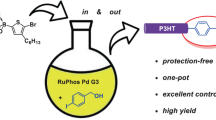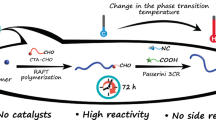Abstract
This focused review provides an overview of our recent work and related research regarding the precise anionic ring-opening polymerization (AROP) of substituted epoxides, including alkylene oxides, glycidyl ethers, and glycidyl amines, using t-Bu-P4 as the phosphazene base catalyst to produce functional polyethers, such as homopolymers, block copolymers (BCPs), and topologically unique polymers. First, the fundamental aspects and applicable monomer scope of t-Bu-P4-catalyzed AROP are discussed. Subsequently, the applications of well-defined polyethers prepared via t-Bu-P4-catalyzed AROP to develop functional materials, such as thermoresponsive polymers and Li+ conducting polymers, are discussed. Finally, the utility of t-Bu-P4-catalyzed AROP in the precise synthesis of star-shaped, cyclic, and multicyclic polymers is presented. Overall, we intend to illustrate the exploitable utility of the present polymerization system for fundamental and advanced polymer research.
This is a preview of subscription content, access via your institution
Access options
Subscribe to this journal
Receive 12 print issues and online access
$259.00 per year
only $21.58 per issue
Buy this article
- Purchase on Springer Link
- Instant access to full article PDF
Prices may be subject to local taxes which are calculated during checkout






Similar content being viewed by others
References
Mark, HF, Bikales, NM, Overberger, CG, Menges, G, Kroschwitz, JI, editors. Encyclopedia of polymer science and engineering; New York: John Wiley & Sons, Inc; 1985. 6.
Chattopadhyay DK, Raju KVSN. Structural engineering of polyurethane coatings forhigh performance applications. Prog Polym Sci. 2007;32:352–418.
Petrović Z, Ferguson J. Polyurethane elastomers. Prog Polym Sci. 1991;16:695–836.
Schmolka IR. A review of block polymer surfactants. J Am Oil Chem Soc. 1977;54:110–116.
Gupta S, Tyagi R, Parmar VS, Sharma SK, Haag R. Polyether based amphiphiles for delivery of active components. Polymer. 2012;53:3053–3078.
Booth C, Attwood D. Effects of block architecture and composition on the association properties of poly(oxyalkylene) copolymers in aqueous solution. Macromol Rapid Commun. 2000;21:501–527.
Penczek S, Cypryk M, Duda A, Kubisa P, Słomkowski S. Living ring-opening polymerizations of heterocyclic monomers. Prog Polym Sci. 2007;32:247–282.
Price C. Polyethers. Acc. Acc Chem Res. 1974;7:294–301.
Brocas A-L, Mantzaridis C, Tunc D, Carlotti S. Polyether synthesis: from activated or metal-free anionic ring-opening polymerization of epoxides to functionalization. Prog Polym Sci. 2013;38:845–873.
Herzberger J, Niederer K, Pohlit H, Seiwert J, Worm M, Wurm FR, et al. Polymerization of ethylene oxide, propylene oxide, and other alkylene oxides: synthesis, novel polymer architectures, and bioconjugation. Chem Rev. 2016;116:2170–243.
Ding J, Heatley F, Price C, Booth C. Use of crown ether in the anionic polymerization of propylene oxide—2. Molecular weight and molecular weight distribution. Eur Polym J. 1991;27:895–9.
Billouard C, Carlotti S, Desbois P, Deffieux A. “Controlled” high-speed anionic polymerization of propylene oxide initiated by alkali metal alkoxide/trialkylaluminum systems. Macromolecules. 2004;37:4038–43.
Raynaud J, Ottou WN, Gnanou Y, Taton D. Metal-free and solvent-free access to α,ω-heterodifunctionalized poly(propylene oxide)s by N-heterocyclic carbene-induced ring opening polymerization. Chem Commun. 2010;46:3203–5.
Song Q, Zhao J, Zhang G, Taton D, Peruch F, Carlotti S. N-Heterocyclic carbene/Lewis acid-mediated ring-opening polymerization of propylene oxide. Part 1: Triisobutylaluminum as an efficient controlling agent. Eur Polym J. 2020;134:109819.
Song Q, Zhao J, Zhang G, Taton D, Peruch F, Carlotti S. N-Heterocyclic carbene/Lewis acid-mediated ring-opening polymerization of propylene oxide. Part 2: toward dihydroxytelechelic polyethers using triethylborane. Eur Polym J. 2020;134:109839.
Misaka H, Tamura E, Makiguchi K, Kamoshida K, Sakai R, Satoh T, et al. Synthesis of end-functionalized polyethers by phosphazene base-catalyzed ring-opening polymerization of 1,2-butylene oxide and glycidyl ether. J Polym Sci Part A: Polym Chem. 2012;50:1941–52.
Schwesinger R, Schlemper H, Hasenfratz C, Willaredt J, Dambacher T, Breuer T, et al. Extremely strong, uncharged auxiliary bases. Monomeric and polymer-supported polyaminophosphazenes (P2-P5). Liebigs. Ann. 1996; 1055–81.
Esswein B, Möller M. Polymerization of ethylene oxide with alkyllithium compounds and the phosphazene base “tBu-P4”. Angew Chem Int Ed. 1996;35:623–5.
Eßwein B, Steidl NM, Möller M. Anionic polymerization of oxirane in the presence of the polyiminophosphazene base t-Bu-P4. Macromol Rapid Commun. 1996;17:143–8.
Eßwein B, Molenberg A, Möller M. Use of polyiminophosphazene bases for ring‐opening polymerizations. Macromol Symp. 1996;107:331–40.
Puchelle V, Du H, Illy N, Guégan P. Polymerization of epoxide monomers promoted by tBuP4 phosphazene base: a comparative study of kinetic behavior. Polym Chem. 2020;11:3585–92.
Misaka H, Sakai R, Satoh T, Kakuchi T. Synthesis of high molecular weight and end-functionalized poly(styrene oxide) by living ring-opening polymerization of styrene oxide using the alcohol/phosphazene base initiating system. Macromolecules. 2011;44:9099–107.
Isono T, Asai S, Satoh Y, Takaoka T, Tajima K, Kakuchi T, et al. Controlled/living ring-opening polymerization of glycidylamine derivatives using t‑Bu‑P4/alcohol initiating system leading to polyethers with pendant primary, secondary, and tertiary amino groups. Macromolecules. 2015;48:3217–29.
Chiang Y-C, Kobayashi S, Isono T, Shih C-C, Shingu T, Hung C-C, et al. Effect of a conjugated/elastic block sequence on the morphology and electronic properties of polythiophene based stretchable block copolymers. Polym Chem. 2019;10:5452–64.
Hans M, Keul H, Moeller M. Chain transfer reactions limit the molecular weight of polyglycidol prepared via alkali metal based initiating systems. Polymer. 2009;50:1103–8.
Hwang E, Kim K, Lee CG, Kwon T-H, Lee S-H, Min SK, et al. Tailorable degradation of pH-responsive all-polyether micelles: unveiling the role of monomer structure and hydrophilic−hydrophobic balance. Macromolecules. 2019;52:5884–93.
Song J, Hwang E, Lee Y, Palanikumar L, Choi S-H, Ryu J-H, et al. Tailorable degradation of pH-responsive all polyether micelles via copolymerisation with varying acetal groups. Polym Chem. 2019;10:582–92.
Isono T, Satoh Y, Miyachi K, Chen Y, Sato S-i, Tajima K, et al. Synthesis of linear, cyclic, figure-eight-shaped, and tadpole-shaped amphiphilic block copolyethers via t‑Bu‑P4‑catalyzed ring-opening polymerization of hydrophilic and hydrophobic glycidyl ethers. Macromolecules. 2014;47:2853–63.
Dentzer L, Bray C, Noinville S, Illy N, Guégan P. Phosphazene-promoted metal-free ring-opening polymerization of 1,2-epoxybutane initiated by secondary amides. Macromolecules. 2015;48:7755–64.
Zhao J, Pahovnik D, Gnanou Y, Hadjichristidis N. Phosphazene-promoted metal-free ring-opening polymerization of ethylene oxide initiated by carboxylic acid. Macromolecules. 2014;47:1693–8.
Isono T, Lee H, Miyachi K, Satoh Y, Kakuchi T, Ree M, et al. Synthesis, thermal properties, and morphologies of amphiphilic brush block copolymers with tacticity-controlled polyether main chain. Macromolecules. 2018;51:2939–50.
Kwon W, Rho Y, Kamoshida K, Kwon KH, Jeong YC, Kim J, et al. Well-defined functional linear aliphatic diblock copolyethers: a versatile linear aliphatic polyether platform for selective functionalizations and various nanostructures. Adv Funct Mater. 2012;22:5194–5208.
Lee J, Han S, Kim M, Kim B-S. Anionic polymerization of azidoalkyl glycidyl ethers and post- polymerization modification. Macromolecules. 2020;53:355–66.
Wilms V, Frey H. Aminofunctional polyethers: smart materials for applications in solution and on surfaces. Polym Int. 2013;62:849–59.
Herzberger J, Kurzbach D, Werre M, Fischer K, Hinderberger D, Frey H. Stimuli-responsive tertiary amine functional PEGs based on N,N‑dialkylglycidylamines. Macromolecules. 2014;47:7679–90.
Reuss VS, Were M, Frey H. Thermoresponsive copolymers of ethylene oxide and N,N-diethyl glycidyl amine: polyether polyelectrolytes and PEGylated gold nanoparticle formation. Macromol Rapid Commun. 2012;33:1556–61.
Reuss VS, Obermeier B, Dinels C, Frey H. N,N-Diallylglycidylamine: a key monomer for amino-functional poly(ethylene glycol) architectures. Macromolecules. 2012;45:4581–9.
Obermeier B, Wurm F, Frey H. Amino functional poly(ethylene glycol) copolymers via protected amino glycidol. Macromolecules. 2010;43:2244–51.
Isono T, Miyachi K, Satoh Y, Sato S-i, Kakuchi T, Satoh T. Design and synthesis of thermoresponsive aliphatic polyethers with a tunable phase transition temperature. Polym Chem. 2017;8:5698–707.
Kim B, Chae C-G, Satoh Y, Isono T, Ahn M-K, Min C-M. et al. Synthesis of Hard−Soft−Hard Triblock Copolymers, Poly(2-naphthyl glycidyl ether)-block-poly[2-(2-(2-methoxyethoxy)ethoxy)ethyl glycidyl ether]-block-poly(2-naphthyl glycidyl ether), for Solid Electrolytes. Macromolecules. 2018;51:2293–301.
Shin E, Lim C, Kang UJ, Kim M, Park J, Kim D, et al. Mussel-inspired copolyether loop with superior antifouling behavior. Macromolecules. 2020;53:3551–62.
Ree JB, Satoh Y, Jin KS, Isono T, Kim WJ, Kakuchi T, et al. Well-defined and stable nanomicelles self-assembled from brush cyclic and tadpole copolymer amphiphiles: a versatile smart carrier platform. NPG Asia Mater. 2017;9:e453.
Ree JB, Lee J, Satoh Y, Kwon K, Isono T, Satoh T, et al. A comparative study of dynamic light and X-ray scatterings on micelles of topological polymer amphiphiles. Polymers. 2018;10:1347.
Aoki S, Koide A, Imabayashi S-i, Watanabe M. Novel thermosensitive polyethers prepared by anionic ring-opening polymerization of glycidyl ether derivatives. Chem Lett. 2002;31:1128–9.
Ray B, Okamoto Y, Kamigaito M, Sawamoto M, Seno K-i, Kanaoka S, et al. Effect of tacticity of poly(N-isopropylacrylamide) on the phase separation temperature of its aqueous solutions. Polym J. 2005;37:234–7.
Jung S, Kwon W, Wi D, Kim J, Ree JB, Kim YY, et al. Hierarchical self-assembly and digital memory characteristics of crystalline−amorphous brush diblock copolymers bearing electroactive moieties. Macromolecules. 2016;49:1369–82.
Isono T, Kamoshida K, Satoh Y, Takaoka T, Sato S-i, Satoh T, et al. Synthesis of star- and figure-eight-shaped polyethers by t‑Bu‑P4‑catalyzed ring-opening polymerization of butylene oxide. Macromolecules. 2013;46:3841–9.
Satoh T, Miyachi K, Matsuno H, Isono T, Tajima K, Kakuchi T, et al. Synthesis of well-defined amphiphilic star-block and miktoarm star copolyethers via t‑Bu‑P4‑catalyzed ring-opening polymerization of glycidyl ethers. Macromolecules. 2016;49:499–509.
Polymeropoulos G, Zapsas G, Ntetsikas K, Bilalis P, Gnanou Y, Hadjichristidis N. 50th anniversary perspective: polymers with complex architectures. Macromolecules. 2017;50:1253–90.
Yamamoto T, Tezuka Y. Cyclic polymers revealing topology effects upon self-assemblies, dynamics and responses. Soft Matter. 2015;11:7458–68.
Haque FM, Grayson SM. The synthesis, properties and potential applications of cyclic polymers. Nat Chem. 2020;12:433–44.
Laurent, BA; Grayson, SM. Synthetic approaches for the preparation of cyclic polymers. Chem. Soc. Rev. 2009;38:2202–13.
Tu X-Y, Liu M-Z, Wei H. Recent progress on cyclic polymers: synthesis, bioproperties, and biomedical applications. J Polym Sci Part A: Polym Chem. 2016;54:1447–58.
Laurent BA, Grayson SM. An efficient route to well-defined macrocyclic polymers via “click” cyclization. J Am Chem Soc. 2006;128:4238–9.
Satoh Y, Matsuno H, Yamamot T, Tajima K, Isono T, Satoh T. Synthesis of well-defined three- and four-armed cage-shaped polymers via “topological conversion” from trefoil- and quatrefoil-shaped polymers. Macromolecules. 2017;50:97–106.
Ree JB, Satoh Y, Isono T, Satoh T. Bicyclic topology transforms self-assembled nanostructures in block copolymer thin films. Nano Lett. 2020;20:6520–5.
Shingu T, Yamamot T, Tajima K, Isono T, Satoh T. Synthesis of m-ABC tricyclic miktoarm star polymer via intramolecular click cyclization. Polymers. 2018;10:877.
Raynaud J, Absalon C, Gnanou Y, Taton D. N-Heterocyclic carbene-organocatalyzed ring-opening polymerization of ethylene oxide in the presence of alcohols or trimethylsilyl nucleophiles as chain moderators for the synthesis of α,ω-heterodifunctionalized poly(ethylene oxide)s. Macromolecules. 2010;43:2814–23.
Rexin O, Mülhaupt R. Anionic ring-opening polymerization of propylene oxide in the presence of phosphonium catalysts. J Polym Sci Part A: Polym Chem. 2002;40:864–73.
Chen Y, Shen J, Liu S, Zhao J, Wang Y, Zhang G. High efficiency organic lewis pair catalyst for ring-opening polymerization of epoxides with chemoselectivity. Macromolecules. 2018;51:8286–97.
Acknowledgements
This work was financially supported by the MEXT Grant-in-Aid for Challenging Exploratory Research (25620089, 16K14000, and 19K22209), JST CREST (JPMJCR19T4), and the Creative Research Institute (CRIS) of Hokkaido University. The author thanks Mr. Yoshinobu Mato (Graduate School of Chemical Sciences and Engineering, Hokkaido University) for kindly providing the schematic diagrams of the architectural BCPs.
Author information
Authors and Affiliations
Corresponding author
Ethics declarations
Conflict of interest
The author declares no competing interests.
Additional information
Publisher’s note Springer Nature remains neutral with regard to jurisdictional claims in published maps and institutional affiliations.
Rights and permissions
About this article
Cite this article
Isono, T. Synthesis of functional and architectural polyethers via the anionic ring-opening polymerization of epoxide monomers using a phosphazene base catalyst. Polym J 53, 753–764 (2021). https://doi.org/10.1038/s41428-021-00481-3
Received:
Revised:
Accepted:
Published:
Issue Date:
DOI: https://doi.org/10.1038/s41428-021-00481-3
This article is cited by
-
Special issue: Polymer degradation for a sustainable future
Polymer Journal (2024)



